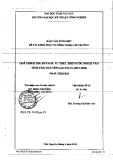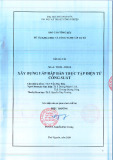
BioMed Central
Page 1 of 3
(page number not for citation purposes)
Journal of Medical Case Reports
Open Access
Case report
Difficult diagnosis of brainstem glioblastoma multiforme in a
woman: a case report and review of the literature
Shaheen E Lakhan* and Lindsey Harle
Address: Global Neuroscience Initiative Foundation, Los Angeles, CA, USA
Email: Shaheen E Lakhan* - slakhan@gnif.org; Lindsey Harle - lharle@gnif.org
* Corresponding author
Abstract
Introduction: Brainstem gliomas are rare in adults. They most commonly occur in the pons and
are most likely to be high-grade lesions. The diagnosis of a high-grade brainstem glioma is usually
reached due to the presentation of rapidly progressing brainstem, cranial nerve and cerebellar
symptoms. These symptoms do, however, overlap with a variety of other central nervous system
disorders. Magnetic resonance imaging is the radiographic modality of choice, but can still be
misleading.
Case presentation: A 48-year-old Caucasian woman presented with headache and vomiting
followed by cerebellar signs and confusion. Magnetic resonance imaging findings were suggestive of
a demyelinating process, but the patient failed to respond to therapy. Her condition rapidly
progressed and she died. At autopsy, a high-grade invasive pontine tumor was identified.
Histological evaluation revealed glioblastoma multiforme.
Conclusion: While pontine gliomas are rare in adults, those that do occur tend to be high-grade
and rapidly progressive. Progression of symptoms from non-specific findings of headache and
vomiting to rapid neurological deterioration, as occurred in our patient, is common in glioblastoma
multiforme. While radiographic findings are often suggestive of the underlying pathology, this case
represents the possibility of glioblastoma multiforme presenting as a deceptively benign appearing
lesion.
Introduction
Brainstem gliomas are rare in adults, with approximately
100 cases reported per year [1]. The majority of tumors
occur in the pons, and in this location tumors are most
commonly high-grade. The clinical presentation is varia-
ble, depending upon the exact location and growth rate of
the lesion. Diagnosis can be difficult, with the differential
including infectious, inflammatory, autoimmune or vas-
culitic disease. Here we report the case of a patient with
glioblastoma multiforme (GBM) that was initially misdi-
agnosed as sinusitis, tension headache, myasthenia gravis
and demyelinating disease. The correct diagnosis was not
reached until autopsy.
Case presentation
A 48-year-old otherwise apparently healthy Caucasian
woman presented to our clinic complaining of headache,
nausea and vomiting for 5 days. Physical examination and
laboratory tests were within normal limits. She was diag-
nosed with tension headache and sinusitis and discharged
on trimethoprim-sulfamethoxazole. The patient returned
to the clinic 3 days later with resolution of her headache
Published: 30 October 2009
Journal of Medical Case Reports 2009, 3:87 doi:10.1186/1752-1947-3-87
Received: 7 April 2008
Accepted: 30 October 2009
This article is available from: http://www.jmedicalcasereports.com/content/3/1/87
© 2009 Lakhan and Harle; licensee BioMed Central Ltd.
This is an Open Access article distributed under the terms of the Creative Commons Attribution License (http://creativecommons.org/licenses/by/2.0),
which permits unrestricted use, distribution, and reproduction in any medium, provided the original work is properly cited.




























